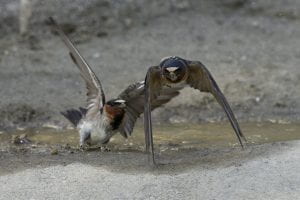After the 2021 nesting season, I was convinced that the cliff swallows has sung their swan song back in 2020. To recap we had made a desperate attempt to preserve and reintroduce some nesting habitat after most of it had been lost by building renovation work and the paving of the fire road that eliminated nearly 1000 square feet of source mud needed for their nest construction. As we recall in 2019 the cliff swallows came late to the BCC campus (Early July). I was hopeful that we were on the right track. Then we had the 2020 nesting season, perhaps I was a little too optimistic. The 2021 nesting season was awful only 1 pair of cliff swallows that came to the campus late in the season successfully fledged young. In 2022, No cliff swallows nested at the BCC campus.
When word got around about a major storm drainage and Sewer system upgrade was about to affect the campus for the summer of 2023, I had hung everything up and thought, Over the past 50 or so years that cliff swallows had been nesting at the main campus, the cliff swallows had a good run, but now it was over. Again, For the 2023 nesting season, I saw a whole lot of nothing.

That was until I was driving down the hill of the Fire Road and saw that characteristic flight pattern and pumpkin colored rump. Could it be? Yup. indeed it was. At the time of this writing, There are 2 occupied nests on Hawthorne Hall on the west side facing south, 1 occupied nest on the SBA Center and 6 occupied nests on Koussavitsky Arts Center. 5 on the west facing and 1 occupied nest on the east side facing the quad. Since Construction work is to be taking place on the ground level as well and window replacements on the side of the Quad. I sent out correspondences to administrators, bringing the situation to their attention since cliff swallows are subject to the Migratory Bird Treaty Act of 1918. I am hopeful the construction workers as well as facilities crew will take the needed precautions to insure the breeding integrity of occupied cliff swallow nest in the vicinity. Cliff swallows are aerial insectivores and have taken a huge decline in their population numbers, somewhere near 60%. With a global mass extinction event currently in progress it is imperative to take whatever precautions we can no mater how seemingly small.
